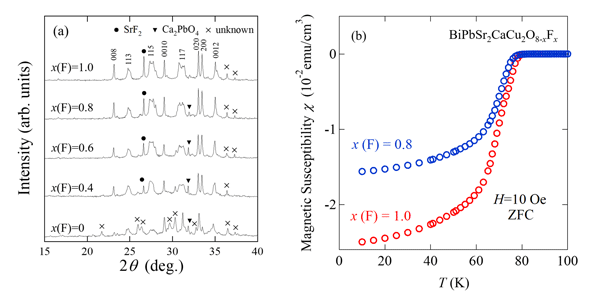PC4-5
Effect of the fluorine substitution for oxygen in the heavily Pb-doped Bi-2212 phase of (Bi,Pb)2Sr2CaCu2O8-δ
Dec.2 10:30-10:45 (Tokyo Time)
Department of Applied Physics, Tohoku University1
The superconducting transition temperature Tc of the Bi-2212 phase of Bi2Sr2CaCu2O8+δ should be higher than 100 K for the practical use of Bi-2212 at liquid N2 temperature. Considering an empirical rule in the cuprate superconductors that Tc increases with increasing distance between Cu2+ and the apical O2-, the substitution of larger Ba2+ for smaller Sr2+ is effective way. Recently, we have succeeded in the Ba2+-substitution for Sr2+ by the heavily Pb2+-substitution for Bi3+ [1]. In BiPbBa2NdCu2O8, however, the hole doping is not realized. This may be because Nd3+ with the larger valence than Ca2+ prevents hole doping into CuO2 phase. Therefore, it is expected that superconductivity appears by the hole-doping in the F--substituted BiPbBa2CaCu2O7F. In this study, we have attempted the synthesis of BiPbSr2CaCu2O8-xFx, which is expected to be easier to be obtained than BiPbBa2CaCu2O8-xFx.
Polycrystalline samples of BiPbSr2CaCu2O8-xFx (0 ≤ x ≤ 1) were prepared by the solid-state reaction method. As shown in Fig. 1(a), the Bi-2212 phase appears as the main phase by the F--substitution although the impurity phases still remain. As shown in Fig. 1(b), the low Tc of ~80 K may be due to the cation nonstoichiometry caused by the formation of the impurity phases. Concludingly, the F-substitution is useful for the formation of the heavily Pb-doped Bi-2212 phase.
[1] T. Watanabe et al., Jpn. J. Appl. Phys. 59, 050902 (2020).
Fig. 1. (a) Powder X-ray diffraction patterns of BiPbSr2CaCu2O8-xFx (0 ≤ x ≤ 1). (b) Temperature dependence of the magnetic susceptibility for BiPbSr2CaCu2O8-xFx (x=0.8, 1.0).
Keywords: Bi-2212, superconducting transition temperture, Pb-substitution, F-substitution
